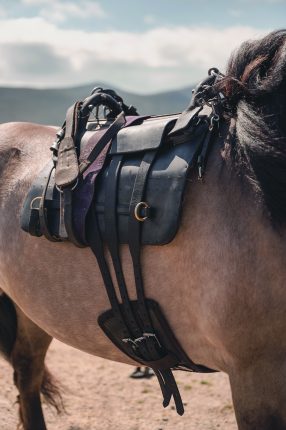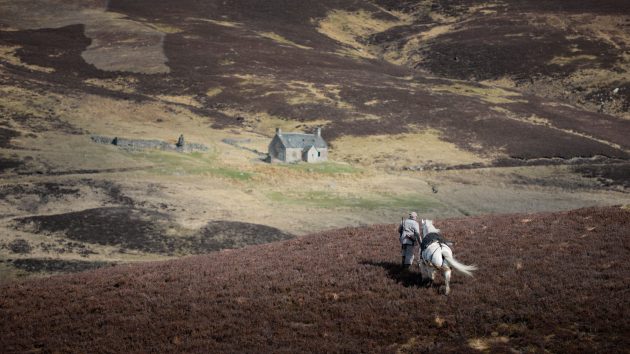For centuries, the garron pony has been a steadfast companion to those who spend their time on the hill – a special partnership that continues to this day says Sophie Clark
The garron pony is as much a symbol of Scotland’s sporting heritage as it is a modern working animal, doughtily getting to places that the Argo can’t reach, and a companion to those who spend their time on the hill. Growing up, I had little experience of horses and ponies. All that changed when I started my college placement as a student gamekeeper at Grosvenor’s Reay Forest estate, one of the handful of sporting estates that still use the garron for deer extraction. Naively I took this for granted and did not appreciate the rarity of my experience. At 18 years old one of my main responsibilities suddenly became these amazing animals. Each one had their own unique character and personality, some easy-going and gentle, others stubborn and cantankerous.

I quickly learned that as well as the pony having to trust me, I had to trust them to navigate the wild and open hillside. Their sense of direction and memory of the land is exceptional and, on the days when it was just me and a pony, I relied on their surefootedness and company. These qualities have been talked and written about for hundreds of years.
In Isolation Shepherd Iain R Thomson documents his four years in Strathfarrar, Ross-shire in the 1950s. ‘Dandy, the hardiest of ponies, small though he was, when once loaded would toddle off home at a fine speed, stag swaying high above his body on the heavy deer saddle. This pony had the sense to stop immediately, should the stag start to slip round his saddle,’ writes Thomson. ‘We often let him go on ahead if there happened to be another pony to load. He would not make any mistake either of path or load and would be waiting at the larder or more likely trying to get into the stable for his feed when we caught up with him. With commendable manners, we were amused that he never dirtied the path, but would step up the hill a little and then carry on.’

Highland ponies are strong and compact, with wide hooves that help them traverse the wet and peaty ground without leaving much or any trace. They also have a great deal of stamina, giving them the ability to carry heavy loads over long distances. An Argo or all-terrain vehicle (ATV) may be a quicker and easier option but is no substitute for ponies on rocky ground and steep glens, and there remain many beats in the Highlands that are accessible only to ponies. This includes at Balmoral. “The ground is diverse here. There are areas where we simply couldn’t take an ATV,” says headkeeper Gary Coutts. “We have five working beats with two ponies allocated to each one. We always work them in pairs. Having company helps settle the ponies and it also provides insurance should we shoot two deer or one of the ponies loses a shoe, for example.”
SURE AND STEADY
The ponies’ steadiness makes them a reliable work colleague. As Donald Sage in Memorabilia Domestica (1899) attests, a pony brings with it valuable knowledge of its environment. ‘I had procured from a friend, Mr Gordon of Breacachadh, a Highland pony, very strong and sure-footed. Having been bred in that district, the animal could find his way through the most sequestered and intricate morasses to his stall, or to the house of his owner, whether by day or by night,’ writes Sage, who goes on to tell how the creature was instrumental, on one occasion, in saving his life.

‘I had to cross a small rivulet in going to Beacachadh from Achness, which then scarcely wet my horse’s hoofs,’ he recalls. ‘A great deal of rain had fallen, however, during Sabbath, and on my return on Monday, the rivulet was flooded. I heedlessly entered it, without thinking of the circumstance, but the force of the stream almost immediately carried both horse and rider down with the foaming current into the lake, into which it emptied about 30 yards below, and from which the stout pony only made his escape, with his rider, by swimming about 40 yards onward to the other shore.’
Such is the romanticism of the garron that Sir Edwin Landseer included them in many paintings. He regularly visited Glenfeshie estate, owned at the time by the Duchess of Bedford, and used one of the estate bothies to work on his paintings. It was here he painted Monarch of the Glen (1851) and The Deerstalkers’ Return (1827), the latter showing my own fourtimes great-grandfather, Malcolm Clark of Auchlean, heading off the hill with two loaded ponies. He was one in a long line of stalkers and gillies from the Clark family who worked and relied on the garron. My grandfather, Duncan Clark, told me of a day he will never forget while working in the hills of Glenfeshie.
“I was coming off the hill with a loaded pony when he suddenly pulled up and refused to walk on over the grassland in front of us. Darkness was creeping in as I tried to coax the pony forward but it walked around the perimeter, taking me with him,” he recalled. “Once I returned to the yard, I was told the grassland was actually a wet marsh that would have swallowed up anyone who tried to cross it. I have no doubt the pony saved my life that day.”

Going back to visit Reay Forest is always a pleasure, but especially when it’s a day spent with the ponies and seeing the special relationship between the stalker and their pony. One of those stalkers is Kevin Wilson, who has a real passion for the history of the garron. “There is a lot of military history, influence and connection around Highland sporting estates and ponies, the most renowned being the Lovat Scouts: a sniper unit made up of deerstalkers in World War II,” he says. “A lot of estate owners were officers and captains, especially during the Crimean War in 1853 and World War I, which was probably to see the last of the British cavalry units in action and on the front line. It is amazing to witness many of the traits we practise today with Highland ponies that most likely stem from stalkers and ponies being a big part in the war efforts over the past few centuries, such as always mounting a pony from the left side.”
Garrons have also returned to the Strathvaich estate after an absence of many decades. “They went off to war and then disappeared. There was a byre and all the kit but no ponies,” explains Bryony Daniels, whose family owns the estate. “There are now six garrons and, absolutely, they have a real future because they are capable of so much more than a machine, not least because of their natural instincts.”
Although these ponies are clever and intuitive, they still require training. And as Gary Coutts insists, “they all have different brains, and a lot of time goes into them”. Work starts at an early age. At Balmoral youngsters are gently familiarised with the smell of blood and a deer pelt. “We’ll put a little blood on our hands when feeding nuts, moving to putting a pelt on the floor and then eventually on the ponies’ backs. It is all very gradual,” he explains. “Their first carry will always be a hind because it is safer. We would usually wait until the following year for a stag.”
‘OPERATOR’ EXPERIENCE

For all the effort that goes into training a garron, Coutts is quick to point out that the experience of the ‘operator’ is equally as important. This is something seconded by David Olds, gamekeeping lecturer at UHI North Highland. “My first job working as a trainee deerstalker was as a ponyboy on an estate called Fealar in Perthshire. Working with the ponies was a memorable time for me and very colourful. Generally, I always worked by myself, taking two ponies out at a time to retrieve culled deer. But on the odd occasion, mainly in the early part of the stag season, I took only one,” he recalls. It was during one of these ‘solo’ missions that Olds realised the job was not straightforward and even steady ponies can have their moments. “I took a pony called Rory out to meet the stalking party and retrieve a stag before the rut had started. He was a young, fit and strong pony. He was also a new addition to Fealar, only being on the estate a few months. I was just assessing whether the load was correctly balanced when the guest’s loose cagoule jacket caught the wind and hit Rory, startling him and causing him to take off by himself.
“My instinct took over and I grabbed his halter, trying to stop him as he charged down the hillside. After 100 yards or so, I finally managed to stop him but not without injury,” admits Olds. “Rory was fine: the stag’s antlers had missed him. But I was less fortunate, catching an antler over the top of my eye. Thankfully, it only caused a cut across my left eyebrow but the scar remains to this day.”
Ruaridh Ormiston is from a renowned family of Highland pony breeders based in the Cairngorms National Park. Their history of stalking and working with ponies goes back centuries. They currently have about 40 Highlands and breed six to eight foals a year. “A pony gillie has to quickly get in tune with the ponies he works with. He has to second-guess what the pony’s going to do next to avoid accidents; if they bolt, they can easily fall over the edge of ravines and down hills,” says Ormiston.
While the deer pony gillie is a less common sight than it once was, in the year of the Highland Pony Society’s centenary it is clear that garrons still play a vital role. Strathvaich is not alone in reinstating or enlarging its herd. “Today we have 14 working ponies plus two youngsters. A couple of years ago we made the decision to start breeding a couple of foals a year to increase the herd size and bring down the average age,” explains Julian Clarke at Atholl Estates. “We’re particular about our bloodlines and have been using stallions from Balmoral.”
Thanks to many estates, and institutions such as UHI North Highland, the ponies and the skills of those who work with them have a future. Students receive hands-on training from enthusiastic and knowledgeable professionals as well as from obliging and (mostly) well-behaved deer ponies. The iconic image of a deer-laden pony will, I hope, be seen for many years to come.




